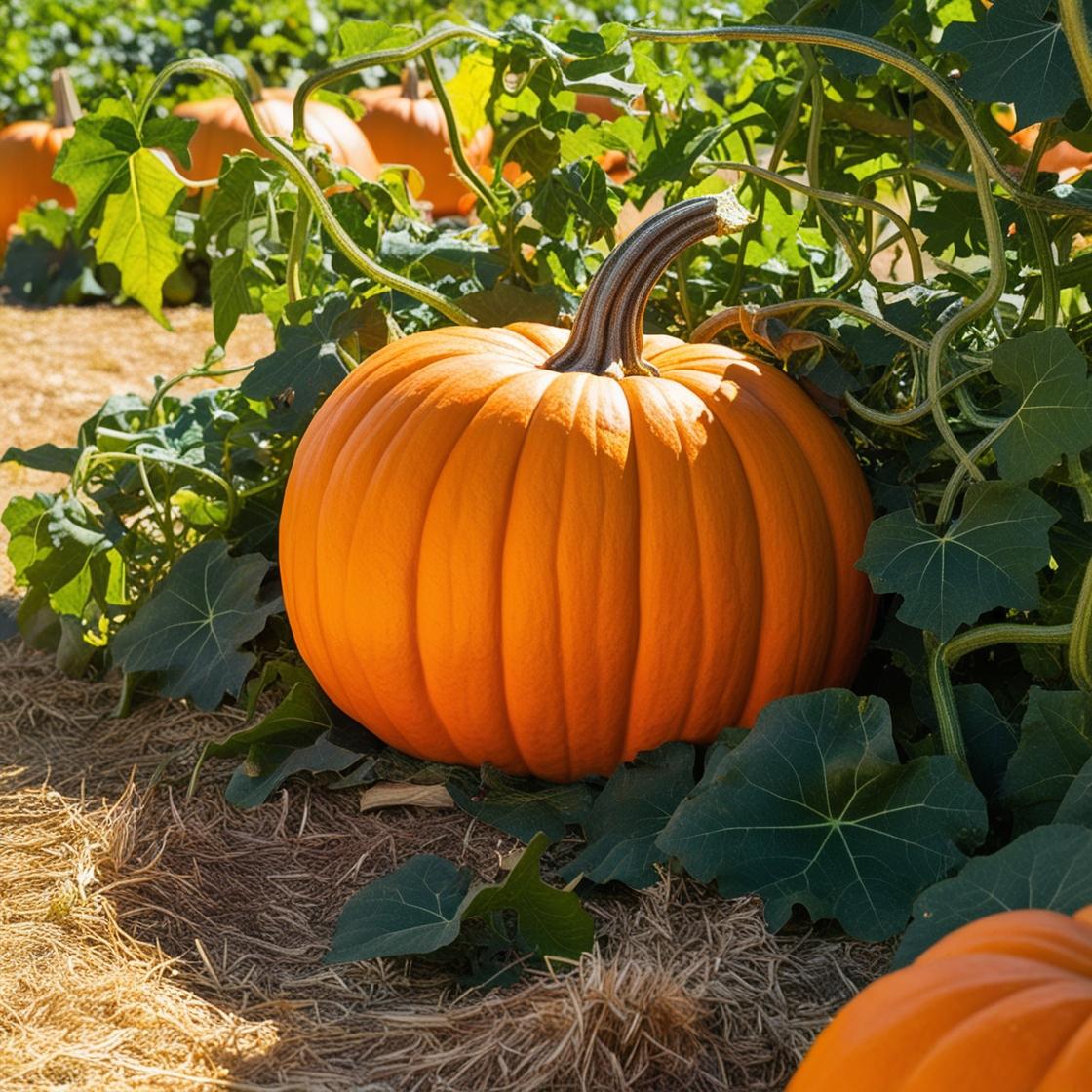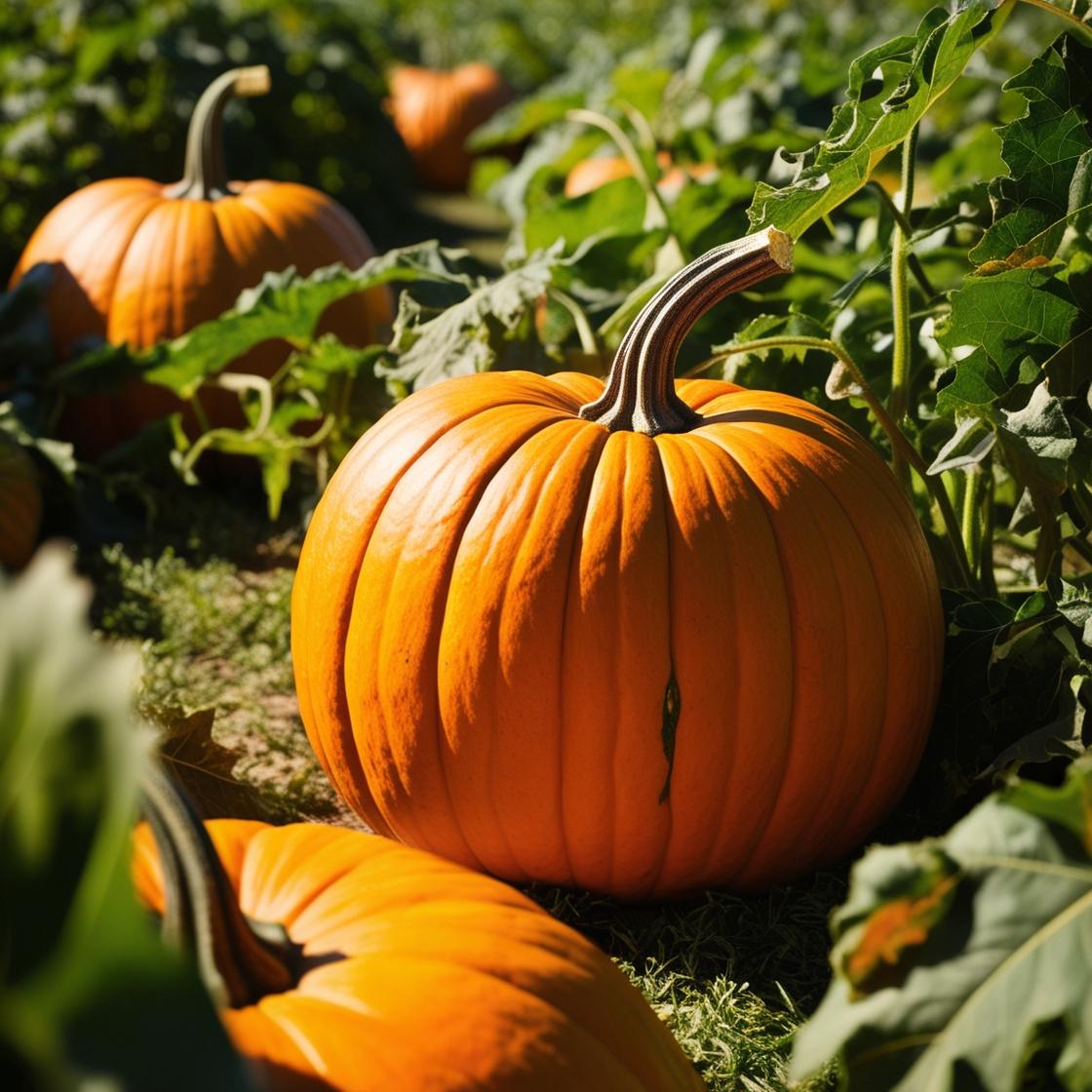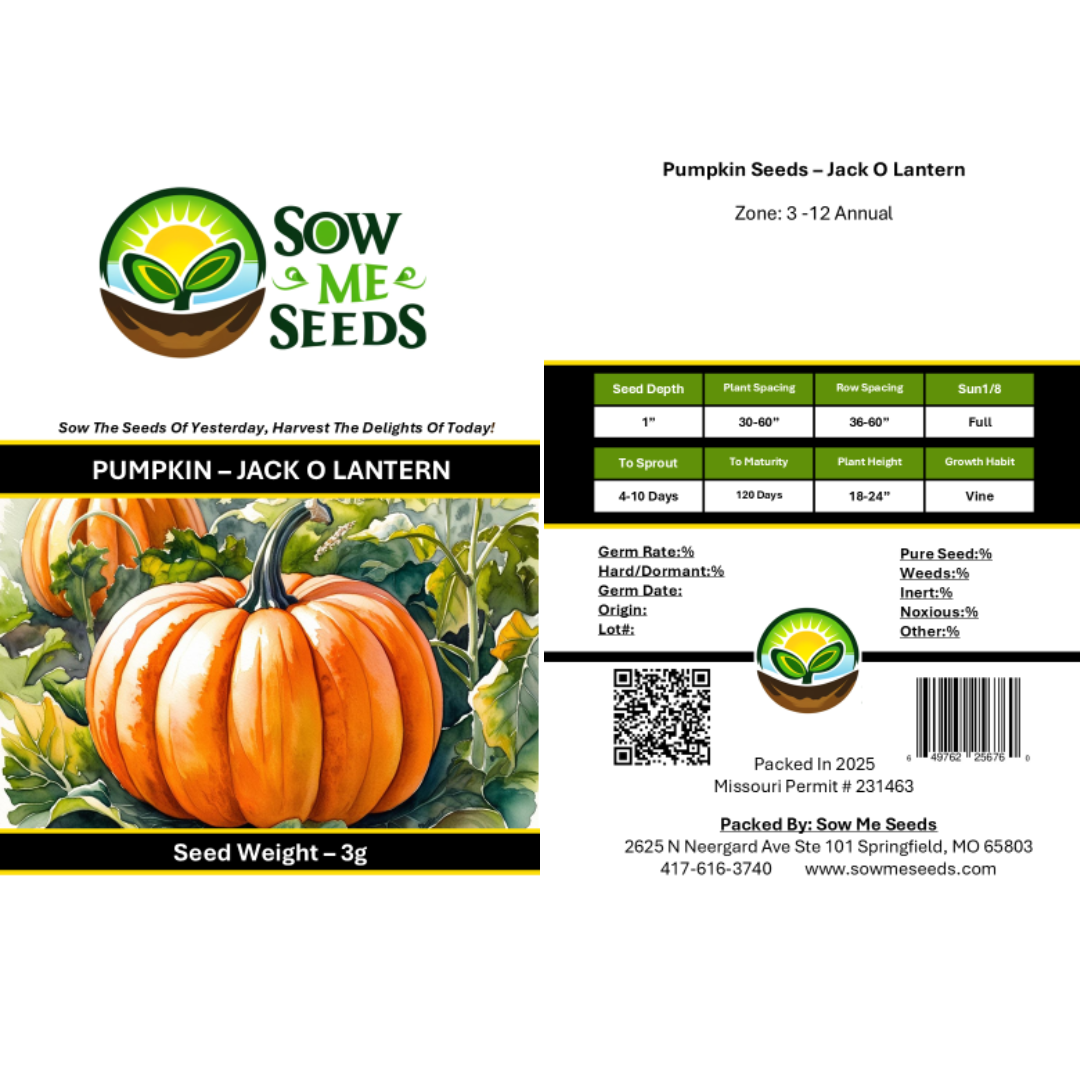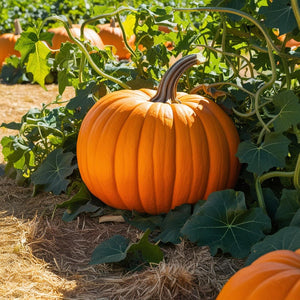- Hardiness Zone: 3-11 Annual
Seed Depth: 1–1.5 inches
Seed Spacing: 24–36 inches
Row Spacing: 6–8 feet
Sunlight: Full sun
Days to Sprout: 7–10 days
Days to Maturity: 100–120 days
Growth Habit: Sprawling vine
Sunlight: Requires full sun, with at least 6–8 hours of direct sunlight daily for optimal growth.
Soil Type: Prefers well-drained, fertile soil with a pH of 6.0–7.5. Enrich soil with compost for the best results.
When to Plant: Sow seeds directly outdoors after the last frost, when soil temperatures reach at least 70°F.
Direct Sowing: Plant seeds 1–1.5 inches deep, spacing them 24–36 inches apart in rows 6–8 feet apart. Alternatively, plant in hills with 2–3 seeds per hill and thin to the strongest seedling.
Indoor Sowing: Start seeds indoors 2–3 weeks before the last frost and transplant carefully to avoid disturbing roots.
Succession Planting: Not typically needed; pumpkins produce a single harvest.
Watering: Water deeply and consistently, keeping the soil evenly moist but not soggy. Avoid overhead watering to reduce disease risks.
Fertilizing: Apply a balanced fertilizer at planting and switch to a phosphorus-rich fertilizer as vines begin to flower.
Pruning: Trim excessive vines to focus energy on fruit development.
Pest and Disease Control: Monitor for squash bugs, vine borers, and powdery mildew. Use organic treatments and row covers as needed.
When to Harvest: Harvest when the skin is bright orange, firm, and the rind is hard, typically 100–120 days after planting. The stem should be dry and woody.
How to Harvest: Use a sharp knife to cut the pumpkin from the vine, leaving 2–4 inches of stem attached to extend storage life. Handle carefully to avoid bruising.
Seed Collection: Scoop seeds from fully ripened fruit, rinse, and dry thoroughly.
Storing Seeds: Store seeds in an airtight container in a cool, dry place.
Why You’ll Love It
Perfect for Carving: Round shape, firm flesh, and strong stems make it ideal for traditional jack-o’-lanterns.
Multi-Purpose: Decorative and edible — great for fall displays and roasting or baking once the holiday passes.
Family Favorite: Easy to grow and harvest, making it a fun crop for kids and beginner gardeners.
Good Storage: Keeps well after harvest when cured properly — great for seasonal decor and kitchen use.
Plant Characteristics
Height: 12–24 inches (vines can sprawl 8–15 feet)
Growth Habit: Vigorous, sprawling vines with large leaves and long runners
Fruit Type: Round, bright orange pumpkins with thick walls and sturdy handles
Fruit Size: Typically 10–20 pounds
Days to Maturity: 90–105 days
Hardiness: Warm-season annual
Flavor and Culinary Uses
Flavor: Mildly sweet and earthy — suitable for cooking but less dense than pie pumpkins
Culinary Uses: Use for roasting seeds, baking, stuffing, or pureeing for soups and savory dishes
Companion Planting Tips
Good Companions: Corn, beans, marigolds, and nasturtiums
Avoid Planting Near: Potatoes (compete for nutrients and space)
Bonus Benefit: Large leaves shade out weeds and help retain soil moisture during hot weather
Common Issues and Solutions
Powdery Mildew: Space plants well for airflow and water at the base to prevent fungal issues
Fruit Rot: Keep pumpkins off damp soil by using straw mulch or boards under maturing fruit
Poor Pollination: Attract bees with companion flowers or hand-pollinate early blooms to boost fruit set
Seeds Per Packet
| 3g | Approximately 21 |
| 10g | Approximately 70 |
Why You’ll Love It
Perfect for Carving: Round shape, firm flesh, and strong stems make it ideal for traditional jack-o’-lanterns.
Multi-Purpose: Decorative and edible — great for fall displays and roasting or baking once the holiday passes.
Family Favorite: Easy to grow and harvest, making it a fun crop for kids and beginner gardeners.
Good Storage: Keeps well after harvest when cured properly — great for seasonal decor and kitchen use.
Plant Characteristics
Height: 12–24 inches (vines can sprawl 8–15 feet)
Growth Habit: Vigorous, sprawling vines with large leaves and long runners
Fruit Type: Round, bright orange pumpkins with thick walls and sturdy handles
Fruit Size: Typically 10–20 pounds
Days to Maturity: 90–105 days
Hardiness: Warm-season annual
Flavor and Culinary Uses
Flavor: Mildly sweet and earthy — suitable for cooking but less dense than pie pumpkins
Culinary Uses: Use for roasting seeds, baking, stuffing, or pureeing for soups and savory dishes
Companion Planting Tips
Good Companions: Corn, beans, marigolds, and nasturtiums
Avoid Planting Near: Potatoes (compete for nutrients and space)
Bonus Benefit: Large leaves shade out weeds and help retain soil moisture during hot weather
Common Issues and Solutions
Powdery Mildew: Space plants well for airflow and water at the base to prevent fungal issues
Fruit Rot: Keep pumpkins off damp soil by using straw mulch or boards under maturing fruit
Poor Pollination: Attract bees with companion flowers or hand-pollinate early blooms to boost fruit set
Seeds Per Packet
| 3g | Approximately 21 |
| 10g | Approximately 70 |





Share and get 15% off!
Simply share this product on one of the following social networks and you will unlock 15% off!